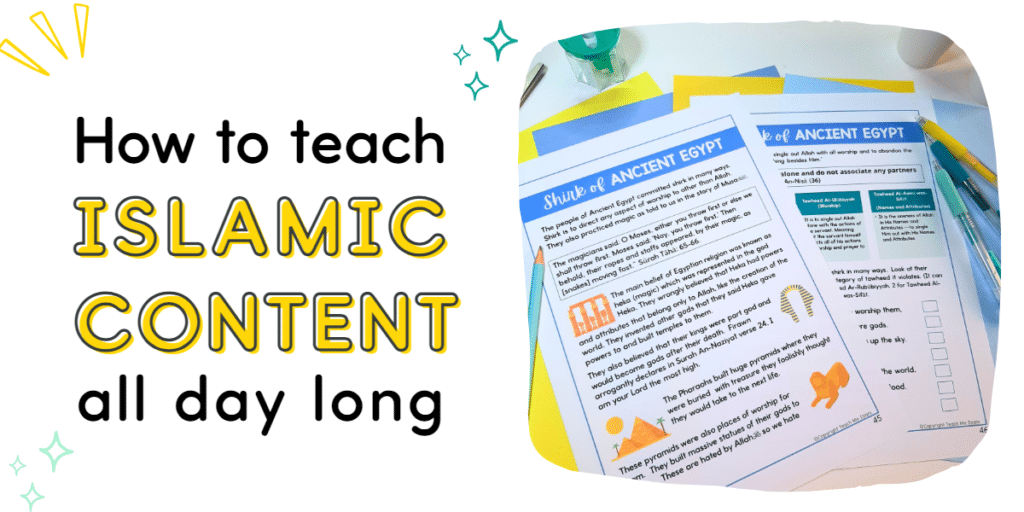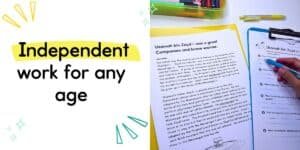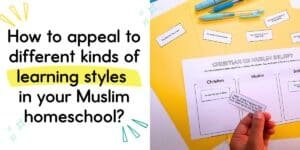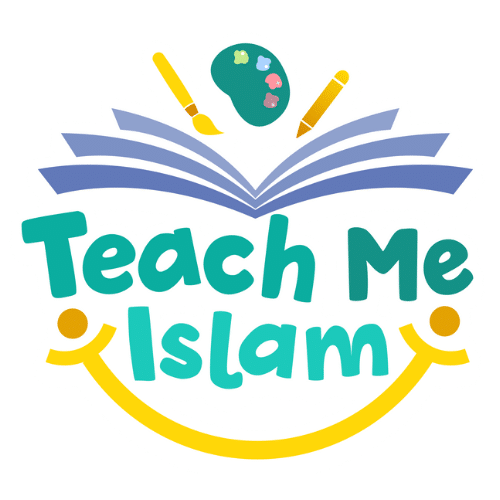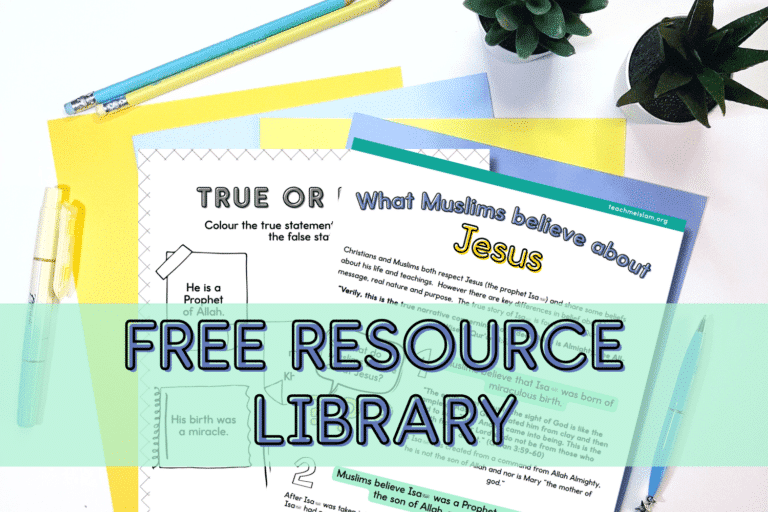Are you Muslim for just an hour a day? Didn’t think so! You’re Muslim every second of everyday and your Islamic values inform everything you do. Islamic Studies should be the same. We can be teaching Islamic content all day long bithnillah.
Of course, most of that education is not formal study. It’s through your example, through prayer in the home, through answers to random questions and through your constant advice and reminding.
However, it can be the same with Islamic Studies. Islamic content can be a part of every subject inshaAllah. It adds barakah as your remember Allah all day long. It also teaches our kids that Islam is holistic, it’s part of all our lives and not just limited to one lesson or subject.

Don’t limit Islamic Studies to one subject.
It’s easy to teach Islamic content just as part of Islamic Studies lessons. This is true especially if you use premade curriculum that is devoid of Islamic content. Islam is such a vast and beneficial subject though, that it feels like trying to grow a plant using a small cup of water instead of letting the rain pour down on it. Let the blessings of Islamic knowledge pour down throughout your day.
There is also so much to cover! You want to teach about aqeedah, fiqh, hadith, quran, tafsir, seerah, stories of the Prophets, the lives of the Companions (may Allah be pleased with them) and more! How would you fit it all in if you teach Islamic studies for a small portion of your day.
Incorporating Islamic material into other subjects enables you to cover so many more topics. This in turn, enables you to have so many more opportunities for tarbiyyah. Seeking knowledge of Islam becomes interwoven throughout your day, increasing the barakah and reward inshaAllah.

Use Islamic Texts in English Lessons
Many of the texts that are recommended for young kids are just not suitable for Muslim kids. Using Islamic texts, the subject matter is not without harm, it’s positively beneficial.
You can use Islamic texts to develop all of the skills needed for reading comprehension and writing.
For example:
Main idea: Use a group of ahadith on a similar theme and ask students to identify the common theme.
Cause and Effect: Reflecting on biographies of famous Companions can you identify reasons for events happening. For example, the Prophet (may Allah raise his rank and grant him peace) made du’aa for Ibn-’Abbas (may Allah be pleased with him) to have understanding of the deen. How can you see the effect of that duaa in his life?
Making Inference: In hadith Jibril, Jibril (alayhi aslaam) is described as wearing a white garment. Why was this noteworthy?
Compare and Contrast: Allah describes the believers and the disbelievers and their actions. Compare and contrast the two.
Sequencing: Put the events of the seerah in order.
Drawing Conclusions: Abu Bakr As-Siddiq (may Allah be pleased with him) believed in the Messenger and supported him from the earliest days of Islam what can we infer about his character?
Additionally, using Islamic texts in English lessons is perfect for familiarising your children with Islamic vocabulary. Some words such as ‘verily’ are not often featured in childrens books. Close reading of Islamic passages is a natural way to introduce and explain vocabulary. It also makes Islamic texts accessible for kids. The two biggest factors to understanding a text (once students can decode the words) are vocabulary and background knowledge. Teaching vocabulary and Islamic background knowledge will make it easier for your children to understand original texts like ahadith and Islamic books. This makes them far more likely to read them bithnillah.
Here are some examples of Islamic reading comprehensions based on ahadith and biographies of child Companions (may Allah be pleased with them). You can grab a free one here.

For Geography: explore the Muslim World
There are so many amazing places in the Muslim world with a unique history. Geography lessons provide the perfect opportunity to explore them. Identify where different Prophets were sent, how Islam spread throughout different regions and places of religious significance like Makkah, Madinah and Al-Quds.
You can get creative in your study methods. Try unit studies like these Africa and Islam and Egypt and Islam ones. Or try a virtual field trip, there is a free one available here. Learn more about virtual field trips here.

For History: study the lives of the Prophets and the noble Companions.
A goal of the study of history is the learn lessons from the past. What better lessons can be learnt than from the lives of the Prophets and righteous people. There is an added benefit of providing your children with great role models from a young age bithnillah. They can be studied from a really young age, just add more detail and analysis as they grow older. Try this set of worksheets about the Prophets of Islam or this unit study about Abu Bakr As-Siddiq (may Allah be pleased with him). I have a few free biography packs available in the free resource library, you can sign up below to download immediately.
Jafar bin Abi Talib (may Allah be pleased with him)
Abu ‘Ubaidah bin Al-Jarrah (may Allah be pleased with him)
The Female Companion who cared for Masjid An-Nabawi
Imam Bukhari (may Allah have mercy on him)

For science: ponder on Allah Al-Khaliq.
We are encouraged time and time again to reflect on the signs of Allah from his creation, such as the sun, the moon, the earth and more.
I really love the Islamically integrated units from Homeschool Queens. They are so comprehensive and beautifully designed.

To develop a growth mindset: our deen provides the best guidance.
Encouraging a growth mindset is a hot topic in parenting and education circles at the moment. It’s a useful tool but it is only a tiny part of the picture.
Useful Ways to Live A Happy Life by Shaykh AbdurRahman As-Sadi (may Allah have mercy on him) is a brilliant, practical book that outlines foundational practices to achieve happiness. All of these are rooted in the Quran and Sunnah and are therefore beneficial for Muslims of any age and situation. We’ve been so blessed with this deen that gives us the solution to every problem and the path to happiness in this life and the next.
You can try this workbook based on the text, that is designed for kids age 5-8 using examples that are relevant to them.
Conclusion
I hope this blog post provides some ideas for how to make Islamic content the foundation of your homeschool and not just limited to an Islamic Studies lesson. Comment below with any ideas you have about incorporating Islam into different subjects.
May Allah bless you and your family.
Here are some other blog posts you may be interested in:
Should you use Islamically Integrated Resources or teach Islamic Studies separately?
What are Islamic Comprehension Passages and why you should be using them

